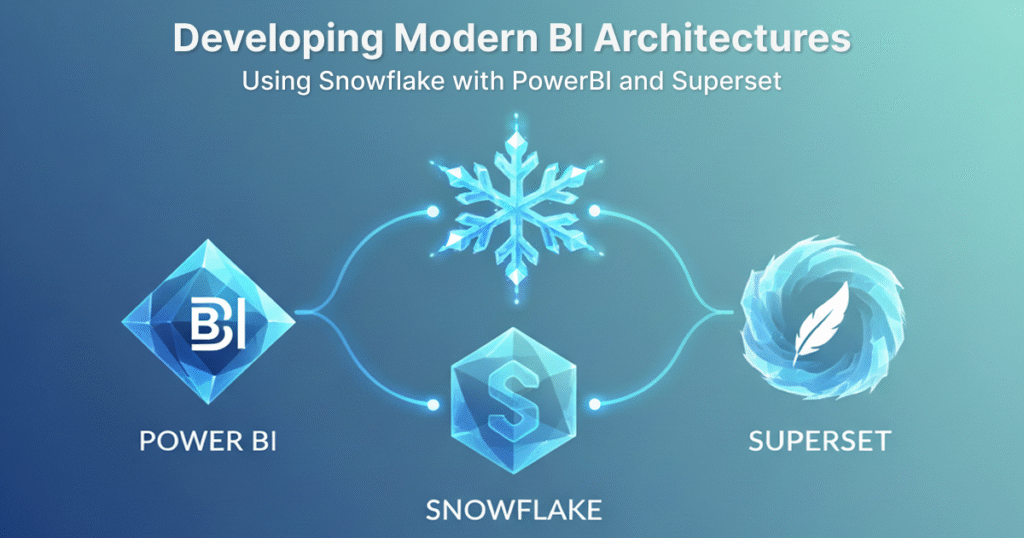The complexity of data today has rendered traditional Business Intelligence (BI) architectures obsolete. Centralizing data is no longer enough; the real challenge lies in making that centralized data accessible, governed, and performant for every type of user, from the executive running an official KPI report to the analyst doing ad-hoc exploration.
This necessity for speed, scale, and flexibility has given rise to the Modern BI Architecture—a decoupled system where a single source of truth (the data warehouse) serves multiple, specialized visualization tools. Our focus today is on one of the most powerful and common configurations: leveraging the Snowflake Data Warehouse as the robust core, integrated with the enterprise standard, Power BI, and the agile open-source explorer, Apache Superset.

Snowflake: The Central Brain of the Architecture
At the heart of this architecture is the Snowflake Data Warehouse. Snowflake’s cloud-native design solves the core problems that used to cripple legacy BI systems: concurrency and performance.
By completely separating storage and compute, Snowflake allows you to scale resources independently. A sudden surge in user reports from the BI layer? Simply spin up a larger or a separate virtual warehouse for that specific workload. This flexibility ensures that the reporting environment remains highly responsive without requiring you to over-provision resources 24/7.
Furthermore, Snowflake serves as the single point of truth. All your data—raw, staged, and modeled—resides here. This eliminates data silos and ensures that both proprietary and open-source tools, like Power BI and Superset, are drawing from the identical, governed source, making it the non-negotiable component of any robust Modern BI Architecture.
Power BI Integration: The Corporate Powerhouse
Microsoft Power BI holds its position as the enterprise standard for a reason. Its strengths lie in its deep integration with the Microsoft ecosystem, its mature features, and its robust data modeling capabilities, which allow analysts to create complex, reusable measures using DAX.
The key to a successful Power BI Integration with Snowflake is optimizing the connection modes:
1. DirectQuery Mode: This is often the preferred choice for massive datasets and reports requiring real-time insights. In this mode, Power BI sends live queries directly to the Snowflake Data Warehouse. Optimization here is paramount, requiring practices like maximizing query folding (pushing transformations back to Snowflake) and setting up dedicated, appropriately sized Snowflake virtual warehouses for BI workloads.
2. Import Mode: Used for smaller, highly aggregated datasets. While it offers faster dashboard load times by storing the data in Power BI’s engine, it requires scheduled refreshes and consumes memory within Power BI, making DirectQuery generally superior for querying truly large volumes on Snowflake.
Apache Superset Analytics: The Open-Source Agility Layer
While Power BI handles the official dashboards and complex data modeling, a Modern BI Architecture needs agility. This is where Apache Superset Analytics plays a critical, complementary role.
As a fast, lightweight, open-source data visualization platform, Superset is ideal for:
1. Ad-hoc Exploration: Analysts and data scientists can quickly spin up charts and test hypotheses using its powerful SQL Lab feature, without the need for complex desktop tools or licensing overhead.
2. Massive Data Visualization: Superset is built to be a visualization layer only. It does not try to be a data modeling engine; instead, it relies heavily on the underlying database (Snowflake) for all computations. This makes it incredibly efficient at visualizing massive datasets without performance bottlenecks.
3. Custom Embedding: Its open-source nature makes it perfect for embedding dashboards into custom business applications, providing tailored analytical views right where operational teams need them.
By utilizing Apache Superset Analytics, organizations gain the necessary flexibility and cost-effectiveness to democratize data access without incurring high licensing fees for every user.
Designing the Unified Layer: Consistency and Governance
The challenge of using two distinct BI tools is ensuring that they speak the same language. This is achieved by defining a Semantic Layer within the Snowflake Data Warehouse.
Use views, secure views, or transformation tools like dbt to define every key metric (e.g., “Monthly Revenue,” “Active Users”) only once in Snowflake. Both Power BI and Superset then query these defined tables or views. This ensures that no matter which BI tool a user chooses, the business logic and metrics remain perfectly consistent across the organization.
Crucially, governance is centralized in Snowflake via its robust Role-Based Access Control (RBAC). Both the Power BI Integration and the Superset connection should utilize user credentials that inherit their access permissions directly from Snowflake’s roles, guaranteeing data security and compliance across the entire Modern BI Architecture.
Optimization: Controlling Cost and Maximizing Speed
Integrating multiple BI tools with Snowflake requires careful resource management to control costs:
1. Virtual Warehouse Sizing: Assign specific, right-sized virtual warehouses to different BI use cases (e.g., a small warehouse for development and a dedicated, auto-scaling medium warehouse for production dashboards). Ensure auto-suspend is aggressively set to minimize idle compute time.
2. Materialized Views (MVs): For the most common, complex, and heavy-hitting queries shared by both Power BI and Superset, use Snowflake’s Materialized Views. These pre-computed results significantly reduce query time and, subsequently, the credits consumed.
3. Smart Refresh Schedules: Audit and optimize the refresh schedules of Power BI reports in Import Mode. Schedule less critical refreshes during off-peak hours to manage concurrency and lower cost.
This deliberate approach to design and optimization is what defines a successful Modern BI Architecture. It’s about leveraging the best-in-class power of the Snowflake Data Warehouse to deliver both the governance of Power BI Integration and the agility of Apache Superset Analytics, delivering maximum value to every data consumer.
Search
Categories

Author
-
Ramesh is a highly adaptable tech professional with 6+ years in IT across testing, development, and cloud architecture. He builds scalable data platforms, automation workflows, and translates client needs into technical designs.Proficient in Python, backend systems, and cloud-native engineering.Hands-on with LLM integrations, stock analytics, WhatsApp bots, and e-commerce apps.Mentors developers and simplifies complex systems through writing and real-world examples.Driven by problem-solving, innovation, and continuous learning in the evolving data landscape.
